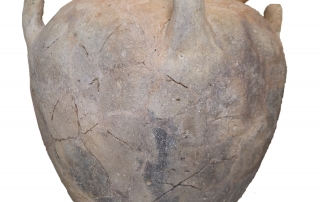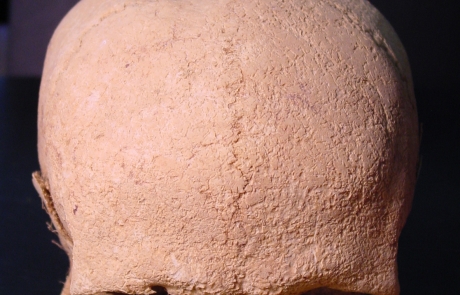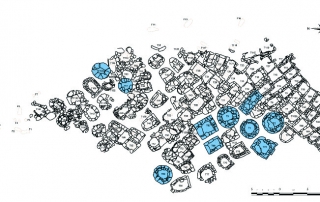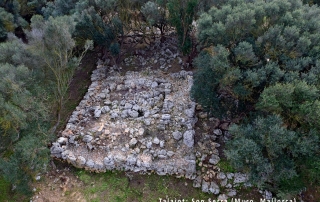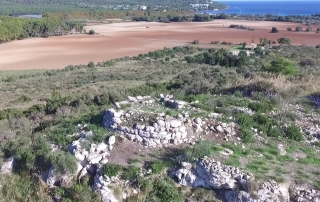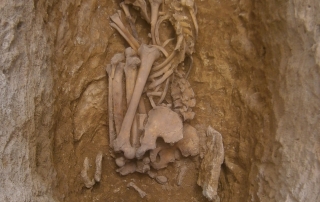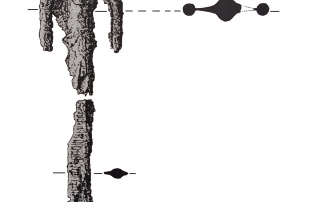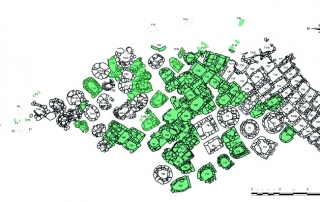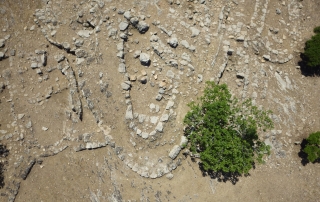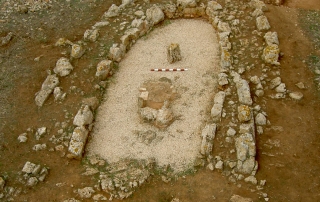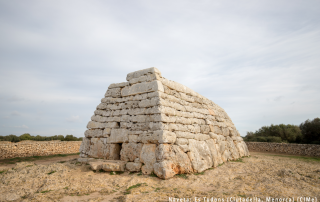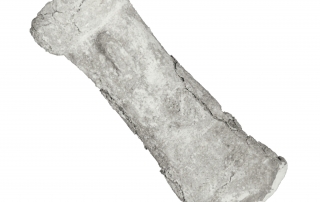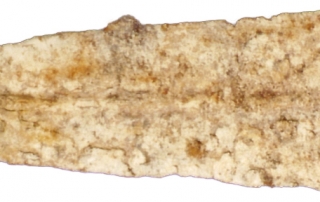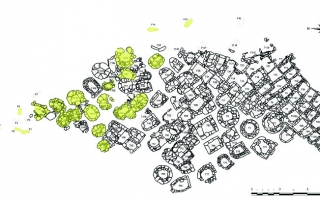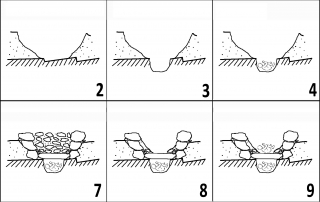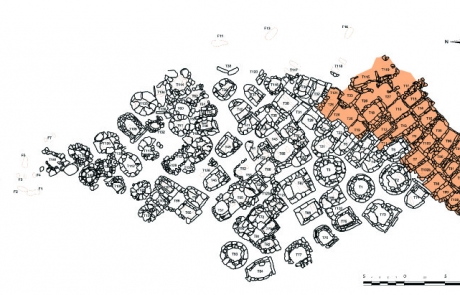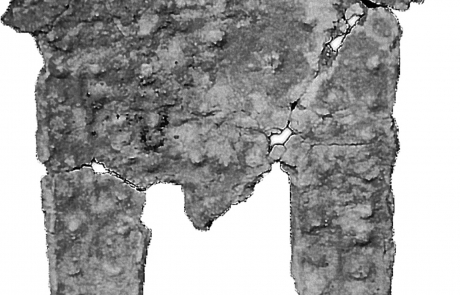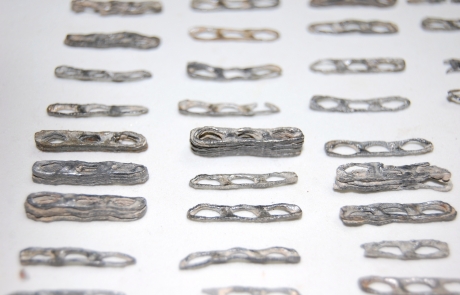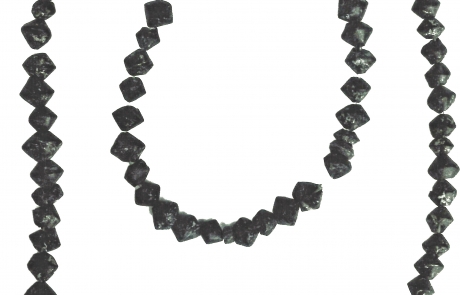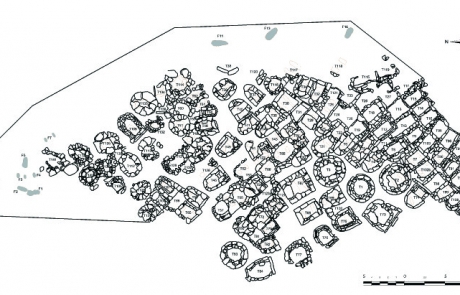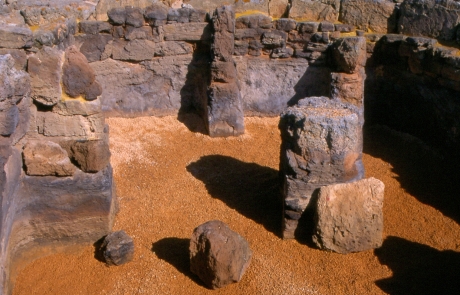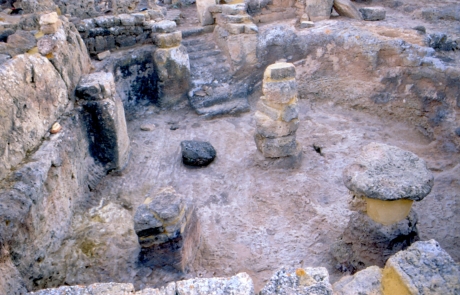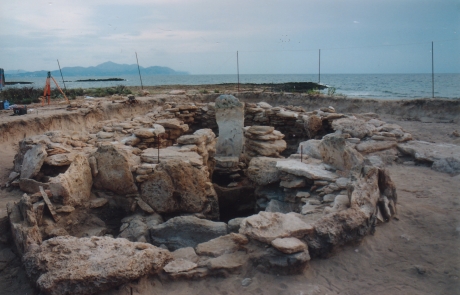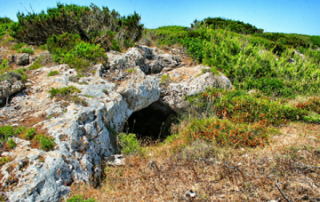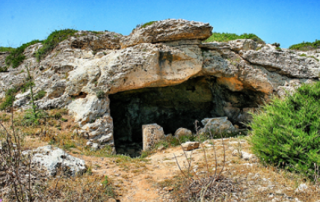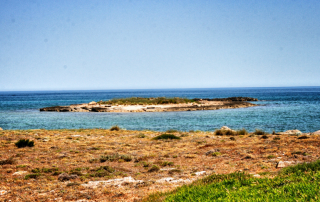The Necropolis of Son Real, the most valuable archaeological site
The Son Real necropolis is the most important site in an archaeologically rich area (1) and one of the most emblematic in Balearic archaeology. The stretch of land where it is located is known as “Punta dels Fenicis” (The Phoenician´s Point), although in fact the individuals buried in this cemetery are indigenous.
Rediscovered in the mid-20th century, excavation and restoration has been completed in two phases: 1957-1969 [2] and 1998-2019. 143 tombs have been found in 935 m2 and the remains of some 425 individuals have been recovered, as well as large quantities of pottery (3), bone (4 & 5), glass and metal fragments belonging to tools, weapons, vessels (3) as well as other items associated with personal (4) or ritual (5) use.
Monumental tombs of this kind are unique to Mallorca, where the vast majority were buried in caves and rock-cut tombs, as well as other contemporary sites in the West Mediterranean. Between the 7th and 2nd centuries BCE, these tombs were primarily used to bury the high ranking members of their societies. These local communities lived in settlements close to agricultural land some 1,5km from the coast.
A megalithic tomb (c.1750 BC) and two rock-cut tombs (1600-1200 BC) can be found in the Son Real vicinity, evidence of more than 1500 years of funerary and ritualistic use of this stretch of coast line.
The stone used to build these tombs comes from the sandstone platform on which the cemetery stands, evidence of which can be seen from the semi-circular shapes on the northern edge of the point. Dry stone methods were used to stack the stones and slabs of these monuments.
The dead were usually buried in the ground in a tightly flexed position (6); the bodies had been tightly bound in some kind of shroud. The average age of deceased individuals was around 34 years for females and 38 for males. Some skulls show evidence of surgical interventions (trepanation), and some clearly survived their skulls being perforated (7).
The Microtalaiots (1)
The first tombs are a miniature version (2A & 2B) of the most iconic buildings in their settlements: The Talaiots (both square [3 & 4] and round [5 & 6] floor plans). Highly skilled building techniques were employed and tombs were frequently reused over the years. Access was via the roof and rarely through a door.
In this period, the tombs were restricted to sex and age with a bias on deceased adult and elderly men (7); females and the young or infants are less represented.
Warrior Burials (1A)
Some warrior type tombs have been identified. The most important one is a skilfully constructed adult male tomb with a rectangular floor plan (2C). The remains of an iron knife and sword (8) were among the finds discovered. On the other side of the tomb (on top of the stone roofing structure), the remains of a dog were found. The tomb was never opened and hence the memory of the deceased buried inside was kept alive for many generations. He is likely to have been some kind of leader or settlement founder.
The Micronavetas (1)
During the 6th century the Talaiots were abandoned and the Balearic era takes place. A new type of tomb occurs inspired by more ancient monuments, such as the Bronze Age dwellings or “dwelling navetes” (2 & 3), or the early Iron Age Menorcan funerary monuments or “internment navetes” (4), both upturned boat-shaped constructions. In this way, the new elite were establishing a link with the past to justify themselves.
The micronaveta is the most frequent type of monument in the cemetery as well as the most varied in construction. The floor plan is apsidal with two parallel trenches in the interior whose function is as yet unknown but in any case designed to accommodate the deceased. In some, “windows” have been practised on the façade or on the sides of the structure with no obvious practical/ritualistic use attributable; some kind of symbolic meaning is inferred.
The tombs contained anything from one to six individuals (5) and were usually buried with grave goods (6 &7). Access to these burial monuments was restricted to age but not gender (both men and women were buried, but few younger individuals and children).
Circular or oval partially buried tombs (1)
During the same period the micronavetes were being built, a new type of tomb appears in the northern section of the cemetery. Circular or oval in plan, dug into the sand and almost ground level (2), they usually had a stone slab covering the pit that always contained the remains of an adult male (3). Encircling this cover was a wall that acted as burial marker. No grave goods were placed with the deceased and although iron awls have been found, these are likely to have been associated with fastening the funerary shroud.
Ossuary (1A)
The only ossuary identified in the cemetery probably dates from this period, a pit marked by a series of stones where bones (4A) and some iron awls (4B) were disposed of during the clearing process of some nearby tombs. In other examples, bones from earlier burials had been grouped together within the same tomb or thrown outside to make room for new burials.
A violent death
In one of the tombs of this sector, human remains were found with a bronze arrow head lodged inside his ventral cavity (5). This is yet another example of some kind of violent episode, previously identified in Son Real, where some skulls show evidence of injuries (some deadly) incurred by cutting objects.
Rectangular abutted tombs (1)
In the SE sector of the cemetery a group of abutted tombs (one built next to the other) were built. Three rows have been identifies, the oldest being those built against tombs from the earliest phases; the second row is built up against the façades of the first row and the third row against those of the second. This is the only phase where construction in the cemetery takes place towards the interior of the island, away from the point.
In terms of structure, these tombs are quite modest, less visible on the landscape, they tend to reuse stone slabs and blocks from previous tombs and have no roofing structures. On the other hand, grave goods are fairly rich and prestigious and include weapons (2) and other metal finds (3 & 4) (especially bronze [5]) and Punic glass beads (6).
As for burials, 3 with a new practice have been identified (cremations), more frequently associated in this period at the nearby Illot dels Porros necropolis. This could indicate the arrival of a new people or evidence of certain local individuals spending long periods of time away from the island.
Conservation issues
This site has and will have to continue to address several issues affecting its conservation.
Human action has clearly had a negative effect on the site, especially with regards to plundering over the centuries. In the early 1990´s there are reports of people practising motor-cross biking on the actual tombs, or deliberate dismantling or removal of stone blocks. Vandalism has diminished in the past few years and site restoration initiatives are guaranteeing the safety of both the monuments and visitors.
Nevertheless, the biggest threat comes from the proximity to the sea. The salty atmosphere together with temperature fluctuations and the wind cause the gradual deterioration of the sandstone, although the main culprits are indeed the severe storms: 30% of the cemetery has disappeared over the past centuries owing to this phenomenon (1). Evidence of this destruction are the remains of pits cut into the bedrock which can be seen in areas surrounding the cemetery. The most recent major storm took place in November 2001 and damaged some 7 tombs (2). This severe weather also completely destroyed funerary structures on l´Illot dels Porros which had been restored in 1998 (3, 4 & 5), and seriously damaged the Punta de Patró sanctuary which completed its excavation only a few months prior the storm (6 & 7).
As sea levels continue to rise and severe weather conditions become more frequent owing to climate change, we will have to keep a watchful eye on this fragile and most precious part of our heritage.
Follow us!
If you want to receive the latest news, follow us on social networks




